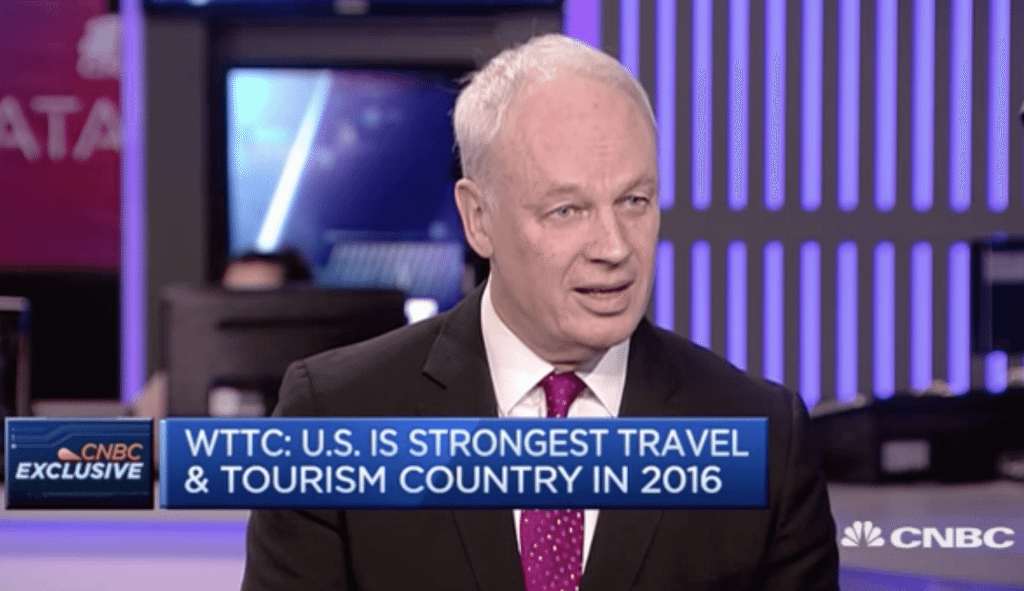Skift Take
Many U.S. destinations will have a harder time this year convincing international travelers that they're affordable and welcoming. But for U.S. travelers, much of the world is their oyster thanks to a continued strong dollar.
President Trump’s travel ban has caused some destinations and tourism organizations to project fewer international visitors to the U.S. in 2017, but the U.S. outbound travel forecast is much brighter.
The number of foreign trips by U.S. travelers is expected to grow 5.4 percent in 2017, according to a new World Travel & Tourism Council (WTTC) and Oxford Economic’s 2017 economic impact report released this week. Canada, Mexico, the Caribbean and Mediterranean destinations in Europe will likely benefit from this strong growth in U.S. outbound travel, the report said.
Travel and tourism growth for North and South America grew 2.4 percent last year and was hurt by weak inbound travel demand to the U.S. but helped by U.S. outbound travel growth. The Americas’ growth for 2016 was higher than Europe (2.0 percent) and the report states that despite a 15 percent drop in the UK pound following the Brexit vote there is little evidence of an inbound travel boost to the UK last year. Any impact on tourism from a weaker pound will likely be felt this year, the report said.
Still, some economic factors in the U.S. and elsewhere such as higher inflation could have a negative impact on tourism.
Higher inflation from rising oil prices — which could increase airfares — and rising debt servicing costs as interest rates rise and a slowdown in job creation across the globe is curbing global consumer spending power to its weakest growth rate in eight years.
The U.S. inflation rate is currently around two percent and will likely stay in that vicinity, said David Scowsill, president and CEO of WTTC.
The U.S. economy’s GDP growth was up 1.9 percent in the fourth quarter 2016 but is now about one percent at the end of the first quarter 2017. “With that slightly slowing growth the direct impact to the U.S. travel forecast for both inbound and outbound travel is about 2.5 percent growth for the year,” said Scowsill.
The global travel industry’s total contribution to global GDP grew by 3.3 percent last year and its direct contribution grew by 3.1 percent. For contrast, the overall global economy grew by 2.5 percent last year — the sixth consecutive year that the travel industry grew faster than the global economy.
One in 10 jobs on the planet are supported by the travel industry and travel brands directly employed 109 million people last year, a 1.8 percent increase of nearly two million new travel jobs directly supported by tourists.
Despite the weaker demand for inbound U.S. travel, the global travel industry has seen a surge in travel from China and Southeast Asia, for example, that’s keeping the industry in the black and travel’s contribution to the global economy is forecast to grow by 3.5 percent in 2017.
The chart below compares the travel industry’s total and direct contribution to the global economy in 2016 from the world’s ten largest outbound tourism markets.
Travel Industry’s Total and Direct GDP Contribution to Global Economy in 2016
| Country | Total ($ billions) | Direct (absolute terms, $ billions) |
|---|---|---|
| U.S. | 1509.2 | 503.7 |
| China | 1000.7 | 275.2 |
| Germany | 376.7 | 138.1 |
| Japan | 343.2 | 110.5 |
| UK | 283.2 | 90 |
| France | 221.3 | 89.8 |
| India | 208.9 | 86.2 |
| Italy | 207.6 | 76.7 |
| Spain | 177.2 | 71.1 |
| Mexico | 165.9 | 63.7 |
Source: World Travel & Tourism Council and Oxford Economics
The Daily Newsletter
Our daily coverage of the global travel industry. Written by editors and analysts from across Skift’s brands.
Have a confidential tip for Skift? Get in touch
Photo credit: U.S. outbound travel looks strong for this year. Pictured is David Scowsill, president and CEO of the World Travel & Tourism Council, speaking to CNBC about the U.S. tourism outlook in 2017. CNBC
